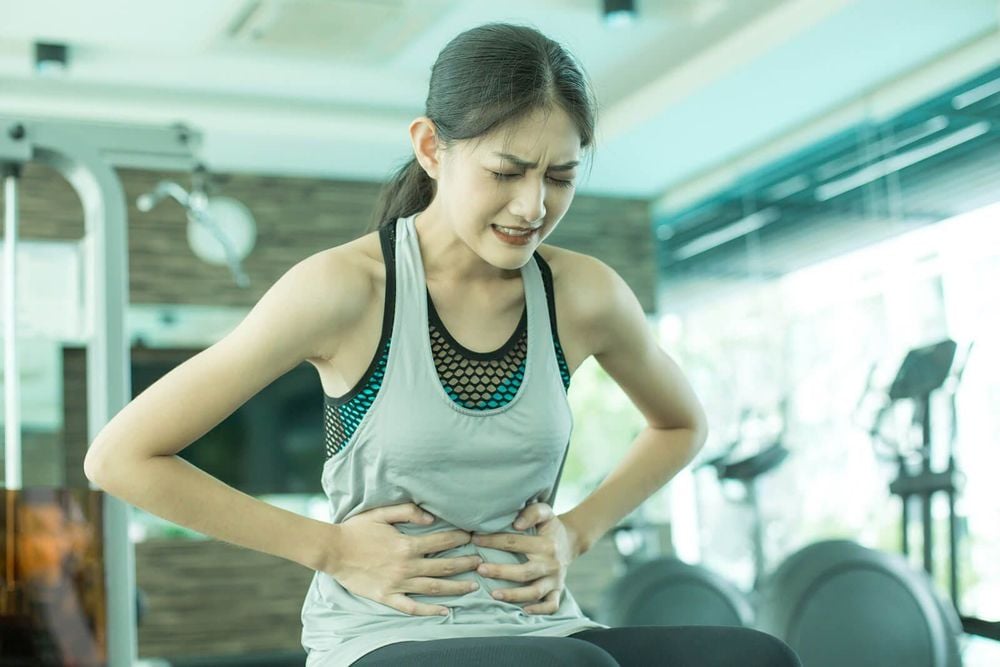Experiencing abdominal muscle pain after the first workout session can leave many feeling fatigued and reduce training efficiency. To alleviate such discomfort, it is essential to warm up your muscles before exercising, avoid overexertion, and maintain a balanced diet.
1. Causes of Abdominal Muscle Pain After Exercise
Abdominal pain often occurs after workouts due to the intensity of the exercise. However, this does not necessarily indicate abdominal injury unless you experience sudden, acute pain during the activity, which might signal a clinical condition or injury.
Common causes of abdominal muscle pain post-exercise include:
Overeating Before Exercise
During physical activity, the body redirects blood flow to vital organs like the heart and brain, reducing the blood supply to abdominal muscles. Concurrently, the digestive and urinary systems receive less blood to prioritize other functions.
If you consume a heavy meal before working out, reduced blood supply to the stomach may cause abdominal pain, nausea, cramping, vomiting, or diarrhea. Experts recommend eating light meals prior to exercising.
Abdominal Muscle Strain
Mild abdominal strain can occur during moderate-intensity exercise. However, overexertion without allowing adequate recovery can place excessive stress on the abdominal muscles. In some cases, extreme strain can lead to microtears in muscle fibers due to excessive bending or twisting, triggering pain.This discomfort is often more pronounced in beginners, as lactic acid accumulation in the muscles can result in burning sensations or soreness.
- Dehydration
Low electrolyte levels also contribute to abdominal muscle soreness during workouts. Staying hydrated before and after exercise is essential to mitigate this issue. Inconsistent Exercise Routine
Irregular abdominal workouts can also cause lower abdominal discomfort. Initially, soreness is common after starting an abdominal workout session. However, with consistent training, this pain typically subsides.If the discomfort persists beyond a few days, consider seeking medical evaluation to identify potential underlying causes.

2. How to Relieve Abdominal Muscle Pain After Exercise
- Apply Heat Therapy
Using a warm compress on the abdomen is an effective way to reduce muscle pain. A warm towel or heating pad can increase blood circulation to the affected area, promoting faster healing of abdominal tissues.
Be cautious not to use excessively hot compresses, as the abdominal area has sensitive skin. Limit each session to about 20 minutes. - Rest and Recovery
If the abdominal pain is severe, it may be necessary to temporarily pause workouts and allow time for recovery. Avoid activities that overstrain the muscles. Once the pain subsides, resume exercises gradually, focusing on core-strengthening activities like planks. - Increase Protein Intake
In order for your abdominal muscles to quickly recover and develop well, you should supplement foods rich in Protein.

3. Tips to Avoid Abdominal Muscle Pain During Exercise
To reduce abdominal muscle pain, you should warm up your muscles before exercising, not overdo it, and have a proSoreness after the first abdominal workout can reduce motivation and performance. To minimize the risk of abdominal discomfort, consider the following:
- Warm up your muscles with light exercises and stretches before engaging in abdominal workouts.
- Maintain a consistent workout routine. Irregular sessions can increase the likelihood of pain, especially after prolonged breaks.
- Allow adequate rest periods between workouts to let the abdominal muscles recover and grow. Avoid overtraining.
- Follow proper techniques, starting with basic exercises suitable for your fitness level. Gradually increase intensity and duration for optimal results.
- Adopt a balanced diet and sufficient rest. Emphasize foods rich in protein, fresh vegetables, and fruits while minimizing the intake of refined carbs and fatty foods to prevent abdominal fat accumulation.
Abdominal soreness after workouts is a common issue that can hinder motivation and reduce workout efficiency. To manage and prevent abdominal muscle pain, warm up before exercising, avoid overexertion, and follow a well-balanced diet. These steps can improve your training experience and support long-term fitness goals.
Please dial HOTLINE for more information or register for an appointment HERE. Download MyVinmec app to make appointments faster and to manage your bookings easily.













